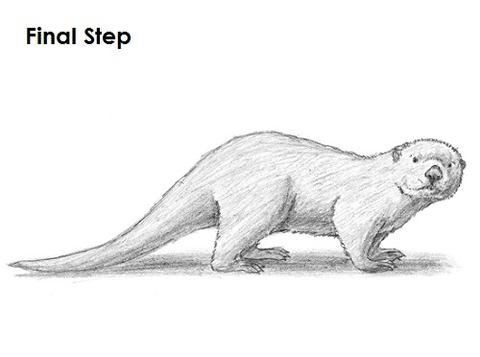Otter Drawing Shouldn’t be hard read those tips to Draw

Otters Drawing
Today we learn Otter Drawing for the first time. Otters are semi-aquatic creatures that occupy five of the seven continents of the world. The Otters have been around for about 30 million years. Today, a miniature plastic art course by Petite Loutre on how to draw an otter is mainly interested in removing the sea otter. Büyük siteler barındıran eşsiz yaşam alanları bulunan ilçemizde beylikdüzü escort kadınlarına çabucak ulaşabileceksiniz web sayfamızda. They don’t live in Australia or Antarctica. There are 13 species of otters. Learn How to draw spiderman from our website.
HOW TO DRAW AN OTTER: STEP BY STEP SEA OTTER DRAWING
For the first few steps, don’t press too hard with your pencil. Use light, smooth strokes to start.
SEA OTTER DRAWING: THE BODY
Step 1 Draw two circles
Draw two rounds as guides for the otter’s body. They don’t have to be perfect. They are only guides. The group should be right next to each other, and the loop on the right should be humbler and slightly below the first circle. Daily world
Step 2 Even smaller circle
Draw an even smaller set on the upper right side as a guide for the otter’s head.
Step 3 two intersecting lines
Draw two intersecting lines on the inside of the head to help you place the otter’s facial features later.
Step 4 two angled lines
Draw two angled lines under the box (one below each circle) to guide the otter’s legs.
Step 5 series of curved lines
Draw a series of rounded lines that connect the main shapes to form the body of the otter.
Step 6 long tail for a river otter
Draw two angled lines that come to a spot on the left side of the foundation as a pattern for the otter’s tail. Draw a high end for a river otter and a lower bottom for a sea otter. That’s it for the original design! From this point on, push harder with your pointer to get a more established method.
SEA OTTER DRAWING: THE FACE
Step 7 otter’s eyes
Draw the otter’s eyes on the inside of the head using the lines as placement guides. Otters have tiny eyes, so they draw them like little circles. Add shadow inside the sights except for a small process to represent sparkle. Add some words about the lamps as an extra detail.
Step 8 otter’s nose
Induce the otter’s nozzle using the trades as situation pilots. First, lightly draw a rock. Then shade the frame and carry it a drunkard frame. Add a few arcs to the sides for the otter’s nostrils and a line that slits the bottom of the nose.
Step 9 otter’s jaws
Draw the otter’s jaws below the beak, managing short, quick strokes to represent the fur. The mouth starts as a short line below the nose, and then it splits in half and curves upward.
Step 10 small bow
Draw a small bow on either side of the head for the ears. Draw a line inside each ear for more features.
Step 11 otter’s head
Use the initial round as a model to drawing the rest of the otter’s head. Otters have the densest fur of any animal, so use quick short strokes to make it look furry. Add more strokes around the muzzle and eyes for more detail.
SEA OTTER DRAWING: PAWS AND TAIL
Step 12 front legs
Use the line as a guide to drawing the front legs of the otter. Draw lightly at the start to get the proper structure. When you’re happy with what you’ve done, darken it. Meanwhile, Draw around the guideline, making the leg thicker on top—the broad legs at the bottom with the webbed toes of the otter. Draw the otter’s leg on the opposite party in a related approach. Utmost of it is secret, so only draw the visible part.
Step 13 line as a model
Use the other line as a model to represent the otter’s back legs in the same direction as the first legs. Also, Don’t forget to remove the leg lightly, then darken it when you have the structure straight. However, The back portion is thicker at the top. So Don’t forget to draw the webbed toes at the back! Draw the noticeable part of the otter’s paw on the other side using the same technique.
Step 14: Otter’s body and tail.
Shade the initial lines to draw the rest of the otter’s body and tail. However, you can add more value throughout your otter drawing for more details.
Step 15 cleaner look
For a cleaner look, erase as many of the initial guidelines as you can. So there is no need to erase them all. On the contrary, It’s okay to leave some. Also, re-sketch any sketch lines that you may have accidentally erased.
Conclusion
Add some shading to your otter design to give it more dimension and volume. Choose the direction of the light source when shading. So that the shadows are consistent with it. On the other hand, it Varies the pressure on your pencil to achieve different degrees of tonal value. Add a cast shadow below. So That will show that the otter does not appear to be floating. However, you can add more value throughout your otter drawing for more details.




